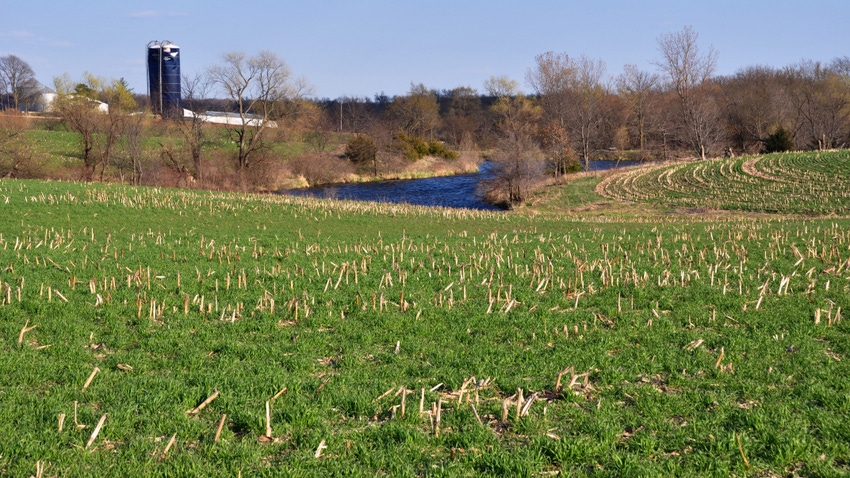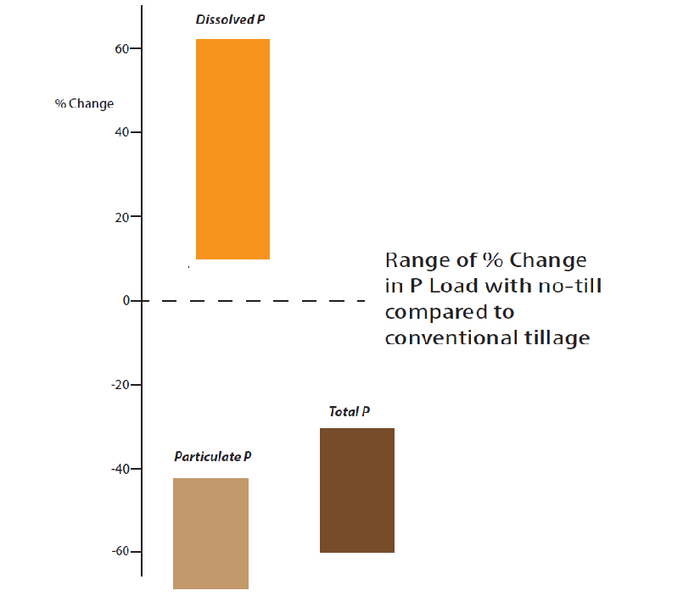August 14, 2018

By Lynn Betts IUPUI
Think Different
The prevalent thought is that since phosphorus (P) is tied to soil particles, no-till is an excellent practice to reduce P loss to water bodies. While it’s true that particulate P loss is significantly less with no-till, dissolved P increases, according to a deep-dive analysis of published research conducted by Indiana University Purdue University Indianapolis (IUPUI). Their review of research indicates no-till needs to be combined with other strategies like cover crops to reduce dissolved P loss.
---------
While it’s known that no-till can significantly reduce soil erosion and runoff volume, research also shows that no-till can increase dissolved phosphorus (P) losses through increased water infiltration and leaching.
Researchers at Indiana University Purdue University Indianapolis (IUPUI) conducted a comprehensive review of many studies on no-till and conventional tillage effects of P loss to water. They synthesized research from 231 data points in 45 studies of soluble and particulate phosphorus concentration loss, and 174 data points in 40 studies on soluble and particulate phosphorus loss between 1985 and 2016. Each of the studies paired no-till versus conventional till (includes disking, chiseling, plowing, etc.) practices, including lysimeter studies under field conditions.
“It’s important to note that in the published research, we found no-till significantly reduced both the load and concentration of particulate P, as well as the total P transferred to aquatic ecosystems,” says Pierre-André Jacinthe, one of three researchers at IUPUI involved in the comparisons of no-till to conventional tillage. “However, no-till resulted in higher concentrations and load of dissolved P; results varied largely with different climate, rainfall, topography, crop species, and number of years crops were in no-till.”
Variations for both dissolved and particulate P, some of which may have differed with overall results, included:
1) Dissolved P concentration was similar in no-till and conventional tillage systems during normal and dry years, and dissolved P loads were similar in no-till and conventional tillage systems during normal and wet years. However, no-till generated significantly higher dissolved P concentration than conventional tillage in wet years.
2) No-till was more effective than conventional tillage in reducing particulate P concentration during normal and dry years, but not during wet years.
3) No-till was most effective at reducing particulate P loss when slope gradient was in the 0 to 3% range. On steeper 4 to 9% slopes, there was no significant difference in the two systems’ ability to reduce particulate P load.
4) Steeper slopes produced similar concentration of dissolved P in both systems, but no-till produced a significantly larger dissolved P load.
5) No-till was less effective in controlling both dissolved and particulate P loss in drylands than in non-dryland regions.
“Overall, the reduction in concentration and load of particulate P, a long-term source of P that fuels biological processes in water bodies, may be one of the most important water quality benefits of no-till farming, since no-till helps keeps soil in place,” says Dr. Stefani Daryanto, a postdoctoral researcher who led the statistical analysis along with Dr. Lixin Wang. “But, these positive impacts are offset by increased dissolved P loads in fields that had been no-tilled for longer than 10 years. Long-term no-till soils may have higher soil organic matter content, better soil moisture retention, and a larger and more active community of soil decomposers. Those are positive impacts for soil, but they may translate into higher P mineralization and higher dissolved P concentration in surface layers with no-till.”


On the other hand, dissolved P presents a different challenge than particulate P. “While dissolved P, particularly orthophosphate, directly causes eutrophication in water bodies because it’s immediately available for biological uptake, particulate P can provide a long-term source of P that fuels biological processes in water bodies,” says Dr. Wang.
Since no-till effectively reduces the amount and concentration of particulate P loss, but not dissolved P loss, the researchers recommend no-till be used with other best management practices. “We recommend practices such as cover crops to scavenge residual P, injection rather than broadcast of P fertilizer, and intercropping or rotating perennial crops with corn, soybeans, and wheat,” Dr. Wang says.
You May Also Like




